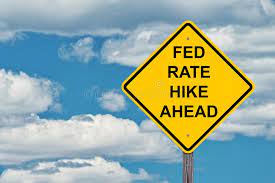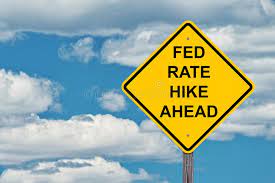
According to a Reuters poll of economists, the US Federal Reserve will start tightening in March with a 25-basis-point rate hike, but an increasing number of people predict the Fed will go for a more aggressive half-point hike to combat inflation.
Inflation continues to grow around the world, but it is especially hot in the United States, where it recently hit a 40-year high.
This is putting pressure on the Fed to not just raise rates from their record lows, but also to shrink its almost $9 trillion balance sheet, which was inflated by emergency bond purchasing during the Covid-19 outbreak.
In a Reuters poll conducted Feb. 7-15, all 84 respondents expected the Fed to raise the federal funds rate by at least 25 basis points at its upcoming March 15-16 meeting, given that the economy has recovered to pre-pandemic levels.
Almost a quarter of those asked (20) projected a 50-basis-point jump to 0.50-0.75 per cent following market discourse during the last week when Fed officials discussed the merits of such a hike. According to rate futures, the chance of a half-point increase is greater than 50%.
Rates were predicted to rise every quarter this year, reaching 1.25-1.50 per cent by the end of December, roughly where they were two years ago when the pandemic began.
One-quarter of respondents (21 of 84) projected rates to be significantly higher by the end of 2022.
"The risk is that at some point ... they'll shift to hiking 50 basis points because it's very unusual for a central bank to have a zero interest rate in the face of the kind of news we're looking at right now," said Ethan Harris, head of global economics research at Bank of America Securities, referring to inflation.
"I do think the Fed is behind the curve. In my view, the Fed should have started hiking last fall, and so they've got some catching up to do."
According to analysts and economists, the Fed will begin lowering its balance sheet sooner than in previous cycles, maybe as early as June or July, just a few months after the first rate hike.
According to the median of 27 responses to a follow-up question, the Fed would begin by reducing its portfolio by $60 billion each month, with estimates ranging from $20 billion to $100 billion.
The government was buying $120 billion per month during the peak of pandemic-related stimulus. Respondents projected the Fed's balance sheet to be worth $5.5 trillion to $6.5 trillion after this so-called "quantitative tightening."
While the central bank's balance sheet would be 30% lighter, as a result, it would still be 30% greater than it was prior to the epidemic.
According to poll respondents, this is not the usual interest rate cycle.
The Fed is only expected to reach a neutral rate, which means one that neither stimulates nor inhibits activity.
Respondents put the terminal rate and their expected neutral rate at the same level, 2.25 to 2.50%, based on median forecasts from preceding questions.
That terminal rate was anticipated to be reached by the end of 2024, signaling a quick tightening cycle by historical standards, which comes with its own set of risks.
"Since nobody knows where the neutral rate exactly is, the Fed could get into restrictive territory earlier than it realizes, and that could ultimately lead to a recession," said Philip Marey, senior U.S. strategist at Rabobank.
(Source:www.reuters.com)
Inflation continues to grow around the world, but it is especially hot in the United States, where it recently hit a 40-year high.
This is putting pressure on the Fed to not just raise rates from their record lows, but also to shrink its almost $9 trillion balance sheet, which was inflated by emergency bond purchasing during the Covid-19 outbreak.
In a Reuters poll conducted Feb. 7-15, all 84 respondents expected the Fed to raise the federal funds rate by at least 25 basis points at its upcoming March 15-16 meeting, given that the economy has recovered to pre-pandemic levels.
Almost a quarter of those asked (20) projected a 50-basis-point jump to 0.50-0.75 per cent following market discourse during the last week when Fed officials discussed the merits of such a hike. According to rate futures, the chance of a half-point increase is greater than 50%.
Rates were predicted to rise every quarter this year, reaching 1.25-1.50 per cent by the end of December, roughly where they were two years ago when the pandemic began.
One-quarter of respondents (21 of 84) projected rates to be significantly higher by the end of 2022.
"The risk is that at some point ... they'll shift to hiking 50 basis points because it's very unusual for a central bank to have a zero interest rate in the face of the kind of news we're looking at right now," said Ethan Harris, head of global economics research at Bank of America Securities, referring to inflation.
"I do think the Fed is behind the curve. In my view, the Fed should have started hiking last fall, and so they've got some catching up to do."
According to analysts and economists, the Fed will begin lowering its balance sheet sooner than in previous cycles, maybe as early as June or July, just a few months after the first rate hike.
According to the median of 27 responses to a follow-up question, the Fed would begin by reducing its portfolio by $60 billion each month, with estimates ranging from $20 billion to $100 billion.
The government was buying $120 billion per month during the peak of pandemic-related stimulus. Respondents projected the Fed's balance sheet to be worth $5.5 trillion to $6.5 trillion after this so-called "quantitative tightening."
While the central bank's balance sheet would be 30% lighter, as a result, it would still be 30% greater than it was prior to the epidemic.
According to poll respondents, this is not the usual interest rate cycle.
The Fed is only expected to reach a neutral rate, which means one that neither stimulates nor inhibits activity.
Respondents put the terminal rate and their expected neutral rate at the same level, 2.25 to 2.50%, based on median forecasts from preceding questions.
That terminal rate was anticipated to be reached by the end of 2024, signaling a quick tightening cycle by historical standards, which comes with its own set of risks.
"Since nobody knows where the neutral rate exactly is, the Fed could get into restrictive territory earlier than it realizes, and that could ultimately lead to a recession," said Philip Marey, senior U.S. strategist at Rabobank.
(Source:www.reuters.com)





